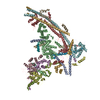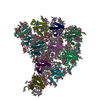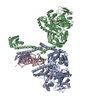+ Open data
Open data
- Basic information
Basic information
| Entry | Database: PDB / ID: 6uxv | ||||||||||||||||||||||||||||||||||||||||||
|---|---|---|---|---|---|---|---|---|---|---|---|---|---|---|---|---|---|---|---|---|---|---|---|---|---|---|---|---|---|---|---|---|---|---|---|---|---|---|---|---|---|---|---|
| Title | SWI/SNF Body Module | ||||||||||||||||||||||||||||||||||||||||||
 Components Components |
| ||||||||||||||||||||||||||||||||||||||||||
 Keywords Keywords | TRANSCRIPTION / SWI/SNF / chromatin remodeler | ||||||||||||||||||||||||||||||||||||||||||
| Function / homology |  Function and homology information Function and homology informationcarbon catabolite activation of transcription / positive regulation of cell adhesion involved in single-species biofilm formation / positive regulation of mating type switching / positive regulation of invasive growth in response to glucose limitation / aggrephagy / HDACs deacetylate histones / DNA strand invasion / rDNA binding / nucleosome array spacer activity / ATP-dependent chromatin remodeler activity ...carbon catabolite activation of transcription / positive regulation of cell adhesion involved in single-species biofilm formation / positive regulation of mating type switching / positive regulation of invasive growth in response to glucose limitation / aggrephagy / HDACs deacetylate histones / DNA strand invasion / rDNA binding / nucleosome array spacer activity / ATP-dependent chromatin remodeler activity / SWI/SNF complex / nucleosomal DNA binding / nuclear chromosome / positive regulation of transcription by RNA polymerase I / histone reader activity / histone H4 reader activity / maturation of LSU-rRNA / : / transcription initiation-coupled chromatin remodeling / cellular response to amino acid starvation / nucleotide-excision repair / helicase activity / double-strand break repair via homologous recombination / Hydrolases; Acting on acid anhydrides; Acting on acid anhydrides to facilitate cellular and subcellular movement / DNA-templated DNA replication / structural constituent of chromatin / double-strand break repair / histone binding / RNA polymerase II-specific DNA-binding transcription factor binding / transcription cis-regulatory region binding / hydrolase activity / chromatin remodeling / chromatin binding / regulation of transcription by RNA polymerase II / chromatin / positive regulation of DNA-templated transcription / positive regulation of transcription by RNA polymerase II / DNA binding / zinc ion binding / ATP binding / nucleus / cytosol Similarity search - Function | ||||||||||||||||||||||||||||||||||||||||||
| Biological species |   | ||||||||||||||||||||||||||||||||||||||||||
| Method | ELECTRON MICROSCOPY / single particle reconstruction / cryo EM / Resolution: 4.7 Å | ||||||||||||||||||||||||||||||||||||||||||
 Authors Authors | He, Y. / Han, Y. | ||||||||||||||||||||||||||||||||||||||||||
| Funding support |  United States, 3items United States, 3items
| ||||||||||||||||||||||||||||||||||||||||||
 Citation Citation |  Journal: Nature / Year: 2020 Journal: Nature / Year: 2020Title: Cryo-EM structure of SWI/SNF complex bound to a nucleosome. Authors: Yan Han / Alexis A Reyes / Sara Malik / Yuan He /  Abstract: The chromatin-remodelling complex SWI/SNF is highly conserved and has critical roles in various cellular processes, including transcription and DNA-damage repair. It hydrolyses ATP to remodel ...The chromatin-remodelling complex SWI/SNF is highly conserved and has critical roles in various cellular processes, including transcription and DNA-damage repair. It hydrolyses ATP to remodel chromatin structure by sliding and evicting histone octamers, creating DNA regions that become accessible to other essential factors. However, our mechanistic understanding of the remodelling activity is hindered by the lack of a high-resolution structure of complexes from this family. Here we report the cryo-electron microscopy structure of Saccharomyces cerevisiae SWI/SNF bound to a nucleosome, at near-atomic resolution. In the structure, the actin-related protein (Arp) module is sandwiched between the ATPase and the rest of the complex, with the Snf2 helicase-SANT associated (HSA) domain connecting all modules. The body contains an assembly scaffold composed of conserved subunits Snf12 (also known as SMARCD or BAF60), Snf5 (also known as SMARCB1, BAF47 or INI1) and an asymmetric dimer of Swi3 (also known as SMARCC, BAF155 or BAF170). Another conserved subunit, Swi1 (also known as ARID1 or BAF250), resides in the core of SWI/SNF, acting as a molecular hub. We also observed interactions between Snf5 and the histones at the acidic patch, which could serve as an anchor during active DNA translocation. Our structure enables us to map and rationalize a subset of cancer-related mutations in the human SWI/SNF complex and to propose a model for how SWI/SNF recognizes and remodels the +1 nucleosome to generate nucleosome-depleted regions during gene activation. | ||||||||||||||||||||||||||||||||||||||||||
| History |
|
- Structure visualization
Structure visualization
| Movie |
 Movie viewer Movie viewer |
|---|---|
| Structure viewer | Molecule:  Molmil Molmil Jmol/JSmol Jmol/JSmol |
- Downloads & links
Downloads & links
- Download
Download
| PDBx/mmCIF format |  6uxv.cif.gz 6uxv.cif.gz | 490.5 KB | Display |  PDBx/mmCIF format PDBx/mmCIF format |
|---|---|---|---|---|
| PDB format |  pdb6uxv.ent.gz pdb6uxv.ent.gz | 331.3 KB | Display |  PDB format PDB format |
| PDBx/mmJSON format |  6uxv.json.gz 6uxv.json.gz | Tree view |  PDBx/mmJSON format PDBx/mmJSON format | |
| Others |  Other downloads Other downloads |
-Validation report
| Summary document |  6uxv_validation.pdf.gz 6uxv_validation.pdf.gz | 884.2 KB | Display |  wwPDB validaton report wwPDB validaton report |
|---|---|---|---|---|
| Full document |  6uxv_full_validation.pdf.gz 6uxv_full_validation.pdf.gz | 963.4 KB | Display | |
| Data in XML |  6uxv_validation.xml.gz 6uxv_validation.xml.gz | 74.1 KB | Display | |
| Data in CIF |  6uxv_validation.cif.gz 6uxv_validation.cif.gz | 113.2 KB | Display | |
| Arichive directory |  https://data.pdbj.org/pub/pdb/validation_reports/ux/6uxv https://data.pdbj.org/pub/pdb/validation_reports/ux/6uxv ftp://data.pdbj.org/pub/pdb/validation_reports/ux/6uxv ftp://data.pdbj.org/pub/pdb/validation_reports/ux/6uxv | HTTPS FTP |
-Related structure data
| Related structure data |  20933MC  6uxwC M: map data used to model this data C: citing same article ( |
|---|---|
| Similar structure data |
- Links
Links
- Assembly
Assembly
| Deposited unit | 
|
|---|---|
| 1 |
|
- Components
Components
-Transcription regulatory protein ... , 3 types, 3 molecules AHI
| #1: Protein | Mass: 194315.094 Da / Num. of mol.: 1 / Source method: isolated from a natural source Source: (natural)  Strain: ATCC 204508 / S288c References: UniProt: P22082, Hydrolases; Acting on acid anhydrides; Acting on acid anhydrides to facilitate cellular and subcellular movement |
|---|---|
| #5: Protein | Mass: 63947.633 Da / Num. of mol.: 1 / Source method: isolated from a natural source Source: (natural)  Strain: ATCC 204508 / S288c / References: UniProt: P53628 |
| #6: Protein | Mass: 19565.189 Da / Num. of mol.: 1 / Source method: isolated from a natural source Source: (natural)   Strain: ATCC 204508 / S288c / References: UniProt: P18888 |
-SWI/SNF chromatin-remodeling complex subunit ... , 2 types, 2 molecules BC
| #2: Protein | Mass: 148065.188 Da / Num. of mol.: 1 / Source method: isolated from a natural source Source: (natural)  Strain: ATCC 204508 / S288c / References: UniProt: P09547 |
|---|---|
| #3: Protein | Mass: 102642.172 Da / Num. of mol.: 1 / Source method: isolated from a natural source Source: (natural)  Strain: ATCC 204508 / S288c / References: UniProt: P18480 |
-Protein , 3 types, 6 molecules DEFGJM
| #4: Protein | Mass: 93034.164 Da / Num. of mol.: 4 / Source method: isolated from a natural source Details: Residues 597-653 and 765-780 of chain F, and residues 609-655 and 763-779 of chain G are not confidently assigned Source: (natural)  Strain: ATCC 204508 / S288c / References: UniProt: P32591 #7: Protein | | Mass: 5720.042 Da / Num. of mol.: 1 / Source method: isolated from a natural source / Source: (natural)  #10: Protein | | Mass: 7081.720 Da / Num. of mol.: 1 / Source method: isolated from a natural source / Source: (natural)  |
|---|
-Protein/peptide , 3 types, 4 molecules KLON
| #8: Protein/peptide | Mass: 2400.951 Da / Num. of mol.: 1 / Source method: isolated from a natural source / Source: (natural)  | ||
|---|---|---|---|
| #9: Protein/peptide | Mass: 1549.902 Da / Num. of mol.: 2 / Source method: isolated from a natural source / Source: (natural)  #11: Protein/peptide | | Mass: 2571.161 Da / Num. of mol.: 1 / Source method: isolated from a natural source / Source: (natural)  |
-Details
| Has protein modification | N |
|---|---|
| Sequence details | The following sequence corresponds to the unknown residue from 151 to the C-terminus for entity-6: ...The following sequence corresponds to the unknown residue from 151 to the C-terminus for entity-6: EMKTQAAELQ |
-Experimental details
-Experiment
| Experiment | Method: ELECTRON MICROSCOPY |
|---|---|
| EM experiment | Aggregation state: PARTICLE / 3D reconstruction method: single particle reconstruction |
- Sample preparation
Sample preparation
| Component | Name: SWI/SNF Body module / Type: COMPLEX / Entity ID: all / Source: NATURAL |
|---|---|
| Molecular weight | Units: MEGADALTONS / Experimental value: NO |
| Source (natural) | Organism:  Strain: ATCC 204508 / S288c |
| Buffer solution | pH: 7.9 Details: 10 mM HEPES, pH 7.9, 10 mM MgCl2, 50 mM KCl, 1 mM DTT, 5% glycerol, 0.05% NP-40 |
| Specimen | Embedding applied: NO / Shadowing applied: NO / Staining applied: NO / Vitrification applied: YES |
| Specimen support | Grid material: COPPER / Grid mesh size: 400 divisions/in. / Grid type: Quantifoil R3.5/1 |
| Vitrification | Instrument: FEI VITROBOT MARK IV / Cryogen name: ETHANE / Humidity: 100 % / Chamber temperature: 277 K |
- Electron microscopy imaging
Electron microscopy imaging
| Microscopy | Model: JEOL 3200FS |
|---|---|
| Electron gun | Electron source:  FIELD EMISSION GUN / Accelerating voltage: 200 kV / Illumination mode: FLOOD BEAM FIELD EMISSION GUN / Accelerating voltage: 200 kV / Illumination mode: FLOOD BEAM |
| Electron lens | Mode: BRIGHT FIELD / Alignment procedure: COMA FREE |
| Specimen holder | Cryogen: NITROGEN Specimen holder model: GATAN 626 SINGLE TILT LIQUID NITROGEN CRYO TRANSFER HOLDER |
| Image recording | Electron dose: 76.5 e/Å2 / Detector mode: COUNTING / Film or detector model: GATAN K2 SUMMIT (4k x 4k) |
- Processing
Processing
| Software | Name: PHENIX / Version: 1.15.2_3472: / Classification: refinement | ||||||||||||||||||||||||||||||||
|---|---|---|---|---|---|---|---|---|---|---|---|---|---|---|---|---|---|---|---|---|---|---|---|---|---|---|---|---|---|---|---|---|---|
| EM software |
| ||||||||||||||||||||||||||||||||
| CTF correction | Details: CTF amplitude correction was performed following 3D auto refinement in relion. Type: PHASE FLIPPING ONLY | ||||||||||||||||||||||||||||||||
| Symmetry | Point symmetry: C1 (asymmetric) | ||||||||||||||||||||||||||||||||
| 3D reconstruction | Resolution: 4.7 Å / Resolution method: FSC 0.143 CUT-OFF / Num. of particles: 61518 / Symmetry type: POINT | ||||||||||||||||||||||||||||||||
| Refine LS restraints |
|
 Movie
Movie Controller
Controller













 PDBj
PDBj


